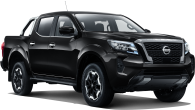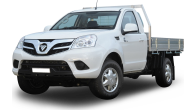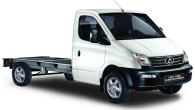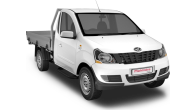The Toyota HiLux partly owes its enviable status as Australia’s most popular ute to its long-standing dominance of 4x2 sales, which mostly attract ABN-armed tradies and fleet buyers chasing rugged no-frills workhorses with low purchase and operating costs combined with strong resale values.
In recent years the D-Max has established a firm foothold as Australia’s second-best selling 4x2 ute. Isuzu’s release of a new cab-chassis variant in January, armed with a smaller and more economical 1.9-litre engine and sub-$30K drive-away pricing, shows competition in this segment is getting hotter. We recently tested Isuzu’s latest addition to its 4x2 range to see if it’s up to the job.
Isuzu D-MAX 2022: SX (4X2) High-Ride
| Engine Type | Diesel Turbo 4, 1.9L |
|---|---|
| Fuel Type | Diesel |
| Fuel Efficiency | 7.0L/100km (combined) |
| Seating | 2 |
| Price From | $29,920 - $36,080 |
| Safety Rating |
|
Does it represent good value for the price? What features does it come with?
Our test vehicle is the 4x2 single cab-chassis in Mineral White and base SX trim. It’s the only model in the D-Max range to offer the new 1.9-litre four-cylinder turbo-diesel, available with either standard six-speed manual for a list price of $31,200 or optional six-speed torque converter automatic like our example for $33,200.
The 1.9-litre is now the cheapest entry to D-Max ownership, with Isuzu offering introductory drive-away pricing from only $29,990 (manual with tray). Given that the federal government has raised its Instant Asset Write-Off threshold from $30K to $150K and extended the scheme until 2023, D-Max buyers could theoretically buy a fleet of five 1.9s at that price and still be eligible.
By comparison, our test vehicle is fitted with Isuzu’s economy aluminium tray ($2887), tow-bar ($1050), 12-pin harness ($359) and electronic brake controller ($820), which adds up to $38,316 plus ORCs.

For that money you also get 17-inch steel wheels with 255/65 R17 all-terrain tyres and a full-size spare. The work-focused cabin offers keyless entry, A-pillar grab handles, wipe-clean vinyl floor with decent-sized left footrest, fabric bucket seats, height and reach-adjustable urethane steering wheel with cruise and audio controls, driver info display, auto wipers, four-speaker infotainment system with 7.0-inch touchscreen display and multiple connectivity including Apple CarPlay/Android Auto and more.

Given that it’s actually a 10.5-inch touchscreen, we can only assume the decision to shrink the SX’s display to 7.0 inches, surrounded by thick black borders, is to provide a point of difference to higher grade models that use the full-size display. Or because SX buyers have smaller fingers. Either way, it serves no useful purpose (unusual for Isuzu) and looks odd.
There’s also benchmark safety, with numerous active features included as standard equipment that are not usually available in cab-chassis workhorses, even as options. These include a reversing camera, blind-spot monitoring and rear cross-traffic alert.
Is there anything interesting about its design?
The 4x2’s high-ride suspension matches the ride height of 4x4 D-Max variants. This offers more than purposeful looks, as the increased ground clearance and approach/departure angles can be useful for tradies accessing rugged worksites or farmers tackling rocky creek crossings.
Adding to its appearance is a body-coloured front bumper that has a more upmarket look than the dark grey plastic bumpers normally seen at this model grade. The old-school telescopic radio aerial fitted to the driver’s A-pillar on previous models, which when extended could be easily snapped off by a low-hanging branch, has been replaced with a sturdier central roof-mounted ‘bee-sting’ design.
The SX’s rugged steel ladder-frame chassis, with 3120mm wheelbase and 12.5-metre turning circle, has twin-wishbone coil-spring front suspension, leaf-spring live rear axle, electric power-assisted steering and front disc/rear drum brakes.

What are the key stats for the engine and transmission?
Isuzu’s new 1.9-litre RZ4E-TC four-cylinder turbo-diesel produces 110kW at 3600rpm and 350Nm between 1800-2600rpm, which is 30kW less power and 100Nm less torque than the familiar 4JJ3-TCX 3.0-litre unit. Interestingly, it also matches the power output of the HiLux's 2.4-litre which is half a litre larger. The 1.9, like its 3.0-litre big brother, meets the Euro 5 exhaust emissions standard, avoiding the need for an AdBlue tank which simplifies maintenance.

The Aisin six-speed auto has fuel-saving torque converter lock-up on third, fourth, fifth and sixth gears. It also offers sequential manual-shifting and ‘intelligent’ electronic control that minimises gear-hunting on climbs and automatically downshifts on steep descents to assist with engine-braking.
There’s no remote-controlled locking diff as found on some rival 4x2 high-riders, but it does come with electronic traction control which Isuzu considers adequate. The diff ratio is also slightly shorter than the 3.0-litre to compensate for the lower power and torque outputs of the smaller engine.
How much fuel does it consume?
Isuzu claims an official combined figure of 7.0L/100km and the dash display was showing 8.8L at the end of our 366km test, of which about a third was hauling its maximum payload.
Our own figure, calculated from tripmeter and fuel bowser readings, came in at 10.3L which is about 1.0L/100km better than we achieved with the 3.0-litre SX dual cab-chassis under similar test conditions. We should also mention that our 1.9-litre SX was fresh off the ship with barely 70km on the odometer when we collected it, so we’d expect that figure to drop into the 9.0L zone or even lower with more running-in of the drivetrain.
So, based on our figure, you could expect a ‘real world’ driving range of more than 700km from its 76-litre tank.
How practical is the space inside?
With its 1620kg kerb weight and 3000kg GVM, our test vehicle has a sizeable 1380kg payload rating. Adding the aluminium tray (149kg) and tow-bar kit (45kg) reduces the payload rating by the same amount but still leaves an ample 1186kg to play with.

It’s also rated to tow up to 3000kg of braked trailer, but to tow that weight with our test vehicle would require a sizeable 500kg reduction in payload to avoid exceeding its 5500kg GCM (or how much it can legally carry and tow at the same time). Alternatively, you could cap the towing limit at 2500kg and restore the full payload. Either way, these are practical numbers for working wheels.
The aluminium tray, which looks identical to rival ‘genuine accessory’ trays we’ve tested, internally measures 2550mm long and 1777mm wide. It has a front bulkhead frame, rattle-free drop-sides that can be easily removed, 16 internal load anchorage points and three external rope rails along each underside.

Cabin storage includes a large-bottle holder and bin in the base of each door, pop-out cup holders in front of the air vents on each side of the dash, overhead glasses holder, single glovebox and a centre console with twin small-bottle holders in the centre and a small lidded box at the rear with a contoured lid that serves as a driver’s elbow rest.
What’s it like as a daily driver?
Decreases of 30kW and 100Nm represent 21 per cent less power and 22 per cent less torque than the 3.0-litre, along with 37 per cent less cubic displacement. However, Isuzu has partly balanced the scales with an 80kg drop in kerb weight. The end result is that power-to-weight ratios are comparatively close, with the 3.0-litre carrying 12.1kg per kW compared to 14.7kg per kW for the 1.9-litre.
How these figures translate to the driving experience is that the smaller engine’s performance doesn’t feel as different as you might expect. The shorter final-drive gearing allows it to operate at the slightly higher rpm it needs to stay within its sweet spot and creates some extra punch when accelerating, particularly from standing starts.
It also has 300Nm of its maximum 350Nm of torque on tap from 1550rpm to 3700rpm; that’s more than 85 per cent of total torque output available across a 2150rpm-wide torque band, which showcases its excellent flexibility.

The shorter gearing also delivers slightly higher but still relaxed revs at highway speeds, with 1600rpm at 100km/h and just under 1800rpm at 110km/h. The adaptive cruise control works well and makes light work of long trips.
The rear suspension is undeniably firm and feels a tad harsher in ride quality than the previous generation, which admittedly had a lower payload rating that may explain the difference. In any case, it’s mercifully more compliant than a 4x2 HiLux cab-chassis equivalent.
It’s also relatively quiet, has good steering feel and braking performance and it’s not hard for drivers of most heights and shapes to find a comfortable position, with its height-and-reach wheel adjustment and well-placed left footrest.
What’s it like for tradie use?
We strapped 975kg on the tray which with our two-man crew equalled a payload of 1125kg that was about 60kg less than the maximum rating.
The nose dropped 25mm while the rear springs only compressed 53mm, leaving 70mm of static bump-stop clearance which was more than ample in ensuring there would be no bottoming-out during our test. As expected, the ride also became smoother with such a big increase in rear spring compression.
The performance of the 1.9-litre engine again exceeded expectations under this weight in city and suburban driving. And on our 13 per cent gradient, 2.0km set-climb at 60km/h, it self-shifted down to third gear (and peak torque) at 2000rpm, easily powering its way to the summit with plenty of accelerator pedal travel remaining.

Testing engine-braking on the way down, in a manually-selected second gear, required some brake pedal to stop it running away from us. As we have come to expect from small displacement (less than 3.0-litre) turbo-diesels, they are strong at hauling loads uphill but less effective at restraining them going down, so no surprises there.
Even so, it proved to be a competent and energetic load-hauler. And also a safe one, thanks in particular to active safety features highlighted earlier including reversing camera, blind-spot monitoring and rear cross-traffic alert. When your load is blocking the central mirror and you’re relying only on smallish door mirrors, these eyes in the back of your head are appreciated.
Warranty & Safety Rating
What safety equipment is fitted? What safety rating?
Maximum five-star ANCAP rating awarded in 2020. Benchmark safety highlighted by eight airbags, AEB, trailer sway control and much more, although front or rear parking sensors are notable omissions in SX grade.
What does it cost to own? What warranty is offered?
The D-Max is covered by a six years/150,000km warranty and up to seven years of roadside assistance if serviced at a participating Isuzu Ute dealer. Scheduled servicing intervals of 15,000km/12 months whichever occurs first. The total capped-price cost of $2794 for the first six scheduled services is $290 less than the 3.0-litre version.
Verdict
The savings in terms of lower purchase price, fuel consumption and servicing costs compared to its 3.0-litre big brother will appeal to tradies and fleet buyers alike. It also proves that a sizeable reduction in engine size doesn’t have to result in a similar decline in performance. As a result, the 1.9-litre D-Max is an economical and willing workhorse that’s sure to win more friends for Isuzu in the 4x2 workhorse market.
Pricing Guides



.jpg)

















.jpg)
.png)
.jpg)



